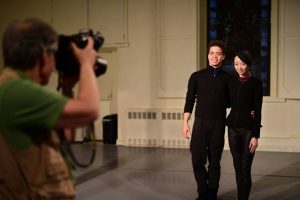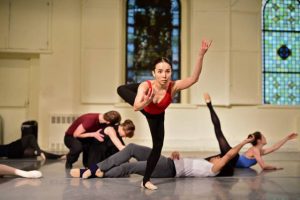

New York Theatre Ballet premieres Legends and Visionaries next week at New York Live Arts. In addition to stagings of Jerome Robbins' Antique Epigraphs and Richard Alston's Such Longing, the concert features a world premiere original ballet set to Philip Glass’s Piano Etudes, co-choreographed by American Ballet Theatre corps member Zhong-Jing Fang, and New York Theatre Ballet veteran company member Steven Melendez.
We sat down with the choreographers after an open rehearsal to discuss the piece, and the rather unique situation they found themselves in with this collaboration.
Have you choreographed together before? How was the process of putting it together?
Steven Melendez: No.
Zhong-Jing Fang: No, we haven’t. This is the first time.
SM: Diana [Bayer], the director of New York Theatre Ballet, saw her work, and she knew my stuff, and thought it would work really well together.
ZJF: It’s very exciting for me. It’s the first real thing I’m choreographing.
SM: The whole piece is ten etudes, but each section works in the context of the entire ballet. Though it’s possible, it would be unfair to take any section as standing alone. The characters are built over the course of the full ballet.
We talked a lot via text and email and in person over coffee about how it would fit together and about which dancers had which characters and which feelings and which movement, and sort of plotted their trajectory throughout the ballet.
This piece is set to Philip Glass’s Etudes. Glass has such a unique quality to his music, and the fact that it’s being performed by steel drums is very interesting as well. Was it the music that inspired the movement, or did you have an idea of the movement first?
ZJF: I have to be honest, it wasn’t easy at first to listen to the piece and get the sense of movement. But then the more I listened to it, it grew on me. And the more we worked with the dancers, the more I saw the picture and we saw the picture of it with the music.
SM: It’s an unusual thing, I think, for the way a choreographer works. First, that neither of us has complete say in what it is, since we’re working together, but also generally I think choreographers choose their music. And this music was given to us. Diana chose her, and she chose me, and she chose the music. And she put the three things together and thought it would work. It would be a totally different thing if we had chosen the music. It also would have been totally different if I had chosen the music and then told her she had to work with it, and vice versa. So we’ve all been trying to fit together. Like a puzzle piece.
Have either of you ever worked that way before?

ZJF: I worked with a group of [American Ballet Theatre's Jacqueline Kennedy Onassis School] students, where a friend who was a composer composed the music, and that was also given to me. So it’s a similar experience for me.
SM: The pieces I’ve done in the past, some have had original compositions, but even then I was working with the composer and had input.
The only thing with these etudes is that the order we’re using them in isn’t the numbered order 1-10. We took the ten of them and rearranged them for the way we wanted to hear them. And the director of NYU Steel was okay with that. We also had to clear it with him.
ZJF: I have found that while it was a challenge, it definitely was intriguing to me why Philip Glass wrote this music like that. So the piece is kind of a search of his journey into that. Within the choreography, it’s kind of digging into his mood and theory and feelings when he wrote the music. And then to interpret it with the dancers. That’s the most inspiring part for me.
While your movement complements each other really well, it seems like you have very different styles of directing a rehearsal and of choreographing. How did you find that in working together?
ZJF: Perfect!
SM: It actually might have been worse if we’d both come in with really strong ideas about what we wanted to do. Or if we both came in with no ideas at all.
ZJF: When I already know what I want, I’m very, very direct. Then in the creating process, I think it’s natural to have a sense of what you get from the dancers also. We inspire each other in that sense.
SM: I think ZJ and I really complement each other. In the sense that she’s really concerned with the characters and the expression of what the movement is trying to say. And I’m very concerned with the actual physical movement and that it is organic and that there is an energy line through it.
I noticed that both of your work is very nuanced, but in different ways. And there are different kinds of details that offset each other nicely. For the storyline, did either of you have an idea beforehand, or did you sit down together and say, “Okay, what do we do here?”
SM: This is my favorite part of the story. ZJ and I individually spoke with Diana, and we run into each other all the time in class at Steps, and in the middle of class I went up and said, “Hey ZJ, my name is Steven, we’re going to be working together.” And she said, “Oh, yeah, it’s good to meet you finally.” And I suggested we go have a coffee after class.
All I had said to her was “Hello, my name is Steven,” and we went into Starbucks and sat down, and she said, “So, what are you afraid of?”
I didn’t even know her and that was the first thing she said. That was the first moment of thinking about what this piece is about.

ZJF: It just always interests me. This is becoming one of the most important parts of my creating process. Each person has a different journey and different things that they’re going through. So that creates an interesting concept. I’m curious about that. That itself -- there’s a lot of material there already. And it’s real. It’s not something we made up in our heads.
I always love in a performance when the audience finds a connection with it. Not just “oh, great performance,” but also what we can leave with them. A message to the audience. I like to work that way. To directly ask dancers and collaborators: what are you afraid of? How can we challenge ourselves?
SM: It’s an interesting thing; the difference between a piece of art that’s meant to be viewed, and a piece of art that’s meant to be experienced. And I think that’s what we’re creating, hopefully something that’s meant to be experienced.
When you do something like a Sleeping Beauty, it’s a performance...it’s...you’re not reliving your time as a princess.
ZJF: It’s from a script.
SM: It’s from a script. And this is different in that the audience doesn’t even need to be there. We could be doing this in our living rooms. It’s a window into the dancers.
ZJF: We’re creating an experience. Not just for the dancers and ourselves, but also for the audience. We almost want it to be like traveling. Like taking a journey.
What do you think the biggest challenge has been?
ZJF: Time.
SM: Time and place. Just coordinating schedules. Getting us both in the same room at the same time. We just started this in October, November. If we could have more time with the dancers, that would be great. But all choreographers want that. Just one more week.
ZJF: I’ve been working with a different company, and the dancers have other rehearsal schedules and other pieces to run. And when I have time, then they don’t have time, and when they have time, then maybe I don’t have time. So it’s always tricky.
SM: Because ZJ’s been at [American] Ballet Theatre, and they just went on tour, it’s been tricky trying to coordinate her schedule. I’m at NYTB all the time, because I work there, so it’s a little bit easier, but I also have rehearsals for all the other pieces we’re performing.
Since you’re both performers as well, how is the shift between being a dancer and being a choreographer?
SM: It’s difficult. I’m choreographing on my coworkers, which is hard.
ZJF: Really. I thought it must be difficult for Steven because at the same time, he has to dance in the same piece that we’re working on.
SM: If I had it my way I wouldn’t dance in the piece.
ZJF: I’m much more relaxed because I don’t have to dance. If I had to think about dancing in the same piece I’m creating, I’d be very stressed.
SM: I was doing my best not to choreograph on myself, but if you take me out and then take a partner out for me, then it looks like an empty stage. And you don’t get the same feeling of a full force. So I ended up choreographing on myself.
So how have you managed that?
SM (laughing): I don’t know! It’s a small company so the dancers know me, and they’re helpful and encouraging so that’s been really nice, but at the moment I’ve been making it up as I go along, learning something new about the rehearsal process every time.
The worst, worst, worst part of it has been this old saying. My mother used to say it: “Do as I say and not as I do.” I know I’m falling over, but you should be able to do it perfectly!
What was the most difficult aspect of the collaboration?

SM: For me it’s been that sometimes I get these midnight bright ideas where I think, “We have to do this, this is the best thing ever!” But then I have to always say, “Oh, well let me talk to ZJ.”
And then just baby disappointments like “Oh, really you don’t like it? Okay, we don’t have to to do it then.”
ZJF: I’ve had the same experience. Where I get very excited. I just told you an idea about how we should start the beginning--
SM: Oh, yeah (laughs).
ZJF: And I was so excited. And if it was just me choreographing, I’d do that. But when you collaborate with someone, you have to ask the other choreographer. So I talked to Steven, and I know he’s not 100%. Maybe not even 50%. And he would tell me by nodding slowly and saying, “Yeah, that’s really nice. Let me think about it. I’ll get back to you.” So normally that’s a no (laughing).
We have to respect each other.
SM: Yeah. I look at it like two heads are better than one. And if for some reason she didn’t like something I did, then maybe my idea wasn’t that good. If it didn’t appeal to her and we agree on a lot of other things, then maybe it was just a midnight idea that should have stayed in a dream.
In the same way that if I had a mentor who came in and was like “What are you doing here?” It’s about respect.
ZJF: It’s also a great challenge to learn how to collaborate. It’s very important for artists to have control, but it’s more difficult to lose that control. But that’s the best art, when you lose some control. That’s what I’m learning.
'Legends and Visionaries' runs at New York Live Arts February 24-27.